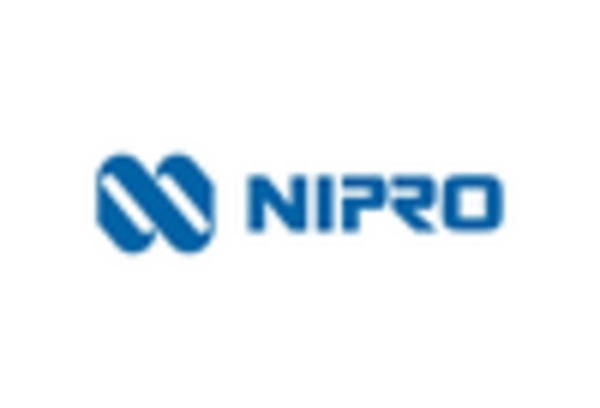Rising Healthcare Expenditure
The increase in healthcare expenditure across various regions is a significant driver for the Arteriovenous Fistula Devices Market. Governments and private sectors are investing more in healthcare infrastructure, which includes the procurement of advanced medical devices. This trend is particularly evident in regions where healthcare reforms are being implemented to improve patient care and access to treatment. For instance, countries are allocating larger budgets for renal care, which encompasses the use of arteriovenous fistula devices for dialysis patients. As healthcare systems prioritize chronic disease management, the demand for these devices is likely to rise, fostering market growth. The correlation between healthcare spending and device adoption is becoming increasingly apparent.
Growing Awareness of Dialysis Options
The increasing awareness among patients regarding dialysis options is driving the Arteriovenous Fistula Devices Market. Educational initiatives and outreach programs are informing patients about the benefits of arteriovenous fistulas over other access methods, such as central venous catheters. This heightened awareness is crucial, as patients who are well-informed about their treatment options are more likely to advocate for the use of arteriovenous fistulas, which are associated with lower infection rates and better long-term outcomes. As more patients seek to understand their treatment pathways, the demand for arteriovenous fistula devices is expected to grow, reflecting a shift towards more effective and patient-preferred dialysis solutions.
Increasing Prevalence of Kidney Diseases
The rising incidence of chronic kidney diseases (CKD) is a pivotal driver for the Arteriovenous Fistula Devices Market. As the global population ages, the prevalence of conditions such as diabetes and hypertension, which are primary contributors to CKD, continues to escalate. According to recent data, approximately 10% of the population is affected by CKD, necessitating effective renal replacement therapies. This growing patient demographic is likely to increase the demand for arteriovenous fistula devices, as they are essential for hemodialysis procedures. The need for reliable and durable access points for dialysis is paramount, thereby propelling the market forward. Furthermore, advancements in device technology may enhance patient outcomes, further driving market growth.
Regulatory Support for Device Development
Regulatory bodies are increasingly supporting the development and approval of innovative arteriovenous fistula devices, which is a key driver for the Arteriovenous Fistula Devices Market. Streamlined approval processes and guidelines aimed at enhancing patient safety are encouraging manufacturers to invest in research and development. This regulatory support not only facilitates the introduction of new devices but also ensures that existing products meet high safety and efficacy standards. As regulations evolve to accommodate technological advancements, manufacturers are likely to respond with innovative solutions that cater to the needs of healthcare providers and patients alike. This dynamic regulatory environment is expected to foster a competitive market landscape.
Technological Innovations in Device Design
Technological advancements in the design and functionality of arteriovenous fistula devices are significantly influencing the Arteriovenous Fistula Devices Market. Innovations such as biocompatible materials, improved catheter designs, and enhanced imaging techniques are being developed to optimize the creation and maintenance of arteriovenous fistulas. These innovations not only improve the success rates of fistula placements but also reduce complications associated with traditional methods. For instance, the introduction of smart devices that monitor blood flow and pressure could potentially enhance patient safety and comfort. As these technologies evolve, they are expected to attract more healthcare providers to adopt arteriovenous fistula devices, thereby expanding the market.


















Leave a Comment